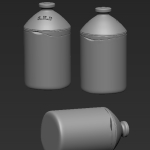
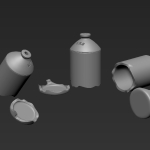
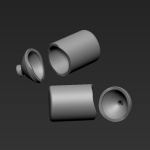
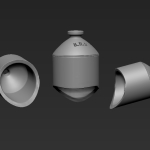
British SRD Rum Jar Set / Bt. SRD Rum-Gefäße Set
- Scale / Maßstab: 1/35 – 1/32
- Material: Resin / Resin
- Parts / Teile: 10
- Infosheet / Infoblatt: English
- Code / Artikel-Nr.: SRD02
- Attention: Not a toy. Model kit or model making accessories – not suitable for children under 14 years of age. / Achtung: Kein Spielzeug. Modellbauzubehör – nicht für Kinder unter 14 Jahren geeignet
GPSR Data / Angaben
- Manufacturer / Hersteller: Jon Smith Modellbau
- Responsible Person / Verantwortliche Person
- Address: Hannoverstr. 68, 29664 Walsrode, Germany
- Contact / Kontakt: info@jonsmith-modellbau.com
- Tel: +49 (0)5161 8255
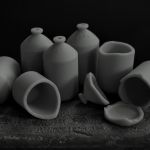
The photo above shows the resin parts (1 x SRD Jar is not on photo)
Contents / Inhalt:
- 4 x SRD Rums / 3 Stck. SRD Rum-Gefäße
- 1 x Cracked SRD Jar / 1 Stck. SRD Gefäß – beschädigt
- 1 x Broken (top) SRD (2 Parts) / 1 Stck. SRD Gefäß – kaputt (oben) 2 Teile
- 1 x Broken (bottom) SRD (2 Parts) / 1 Stck. SRD Gefäß – kaputt (unten) 2 Teile
- 1 x Broken (top half) SRD / 1 Stck. SRD Gefäß – kaputt (obere Hälfte)
Information about this kit:
The British SRD Jar:
The British Army stoneware SRD Rum Jar was a common site throughout the Great War, and many original photographs exist showing these items in and around the front lines and trenches. The jars were still being used during WW11 and certainly with units of the Long Range Desert Group (LRDG) and Special Air Service (SAS) on missions behind Axis lines.
Although mainly associated with the storage of rum, these jars were in fact used for all types of liquid supplies used by the British Army. SRD stands for ‘Supply Reserve Depot’ (or Service Rations Depot depending where you research them). As always the British Soldiers had their own version of what the letters stood for – Seldom Reaches Destination, Soon Runs Dry, Service Rum Diluted and Seldom Rarely Delivers were the most common. The rum was first issued to soldiers during the winter of 1914 to help fight against the extreme cold, wet and damp weather conditions within the trenches and front line areas.
All the British Empire troops fighting on the Western Front would have been issued the rum ration, with of cause the Muslim units being the exception. The daily ration of this thick, dark rum was 1/16th of a pint per man and usually given out in the morning. Of cause a wounded or dying man would also be administered rum as required.
Description: The jars were produced from many contractors and of cause will show differences in height, diameter, weight and colour. Generally, the jars were around 31 – 34cm high, 17 – 18cm in diameter and weighing between 3.2 and 3.6 Kilo. The ceramic glazed jars generally had a light-brown top, to just below the indent rings, with a lighter and greyer, or grey-beige bottom. The glazing was sometimes uneven around the top, showing a slightly wavy dividing line between the colours. The SRD stamps were mainly in a darker colour, almost dark grey or black – some indent stamps had no colouring at all. These letters varied considerably in size, design and position on jar – some were curved, following the contour or shape of jar top.
Notes from the Sculptor
I have created these standard British Army SRD Rum Jars, taking the average measurements from original items, in both the 1:16th scale / 120mm and 1:32nd 54mm / 1:35th scale versions (the difference between the smaller scales is only marginal, remembering the fact that these jars were produced in a mixed assortment of sizes from different manufactures). The damaged and broken versions have again been copied from the original jars found in and around the Western Front and display the typical way of cracking / breaking away of these stoneware vessels. As the cracks on the damaged jar are fine, especially in the smaller scales, I have used a square casting channel for easier identity.
The SRD stamp has been designed as an indentation into the surface of jar top. This has been copied and averaged from a large number of different jar manufacture’s stamp styles and sizes (some curved and some straight). On many examples the stamp is just a coloured marking on or near the top slope of jar. The indent is intended to help the modeller re-produce a realistic stamp impression by filling the indent with a darker coloured, thinner paint and rubbing any excess away from jar outer surface. In reality, these stamps went only a few mm into the jar surface.
I have left the jars without stoppers. The open jar necks can be drilled out, giving further depth and realism to these items.
 An deutschsprachige Interessenten:
Sie können mich per eMail oder Telefon auch gerne auf deutsch kontaktieren. Ortsbesuch ist nach Absprache möglich.
An deutschsprachige Interessenten:
Sie können mich per eMail oder Telefon auch gerne auf deutsch kontaktieren. Ortsbesuch ist nach Absprache möglich.
